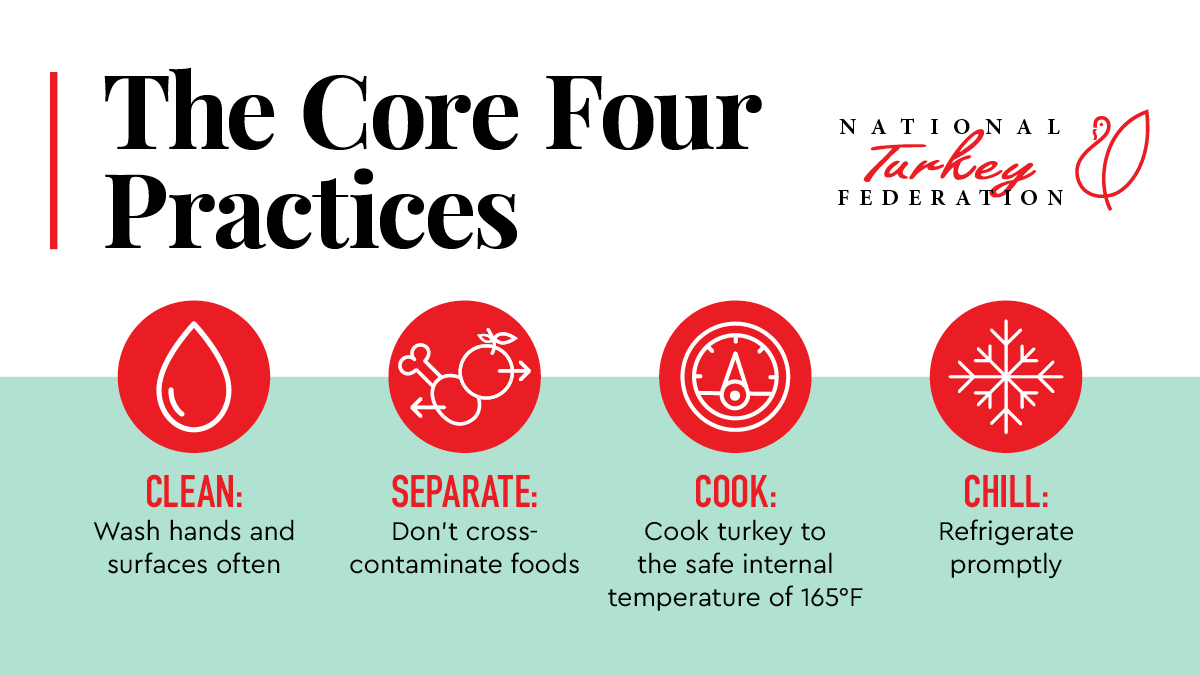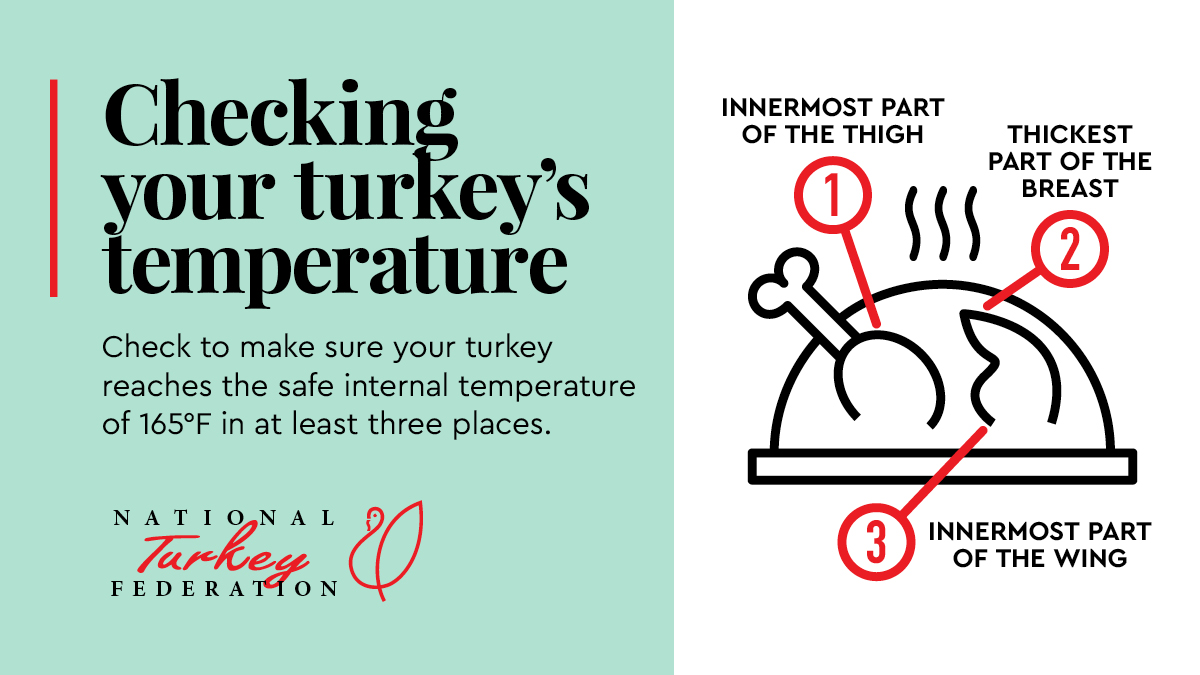Turkey Talk: Preparing the Perfect Feast
November 26, 2022
By Kriss Nelson, Iowa Soybean Association
As you plan to gather with family at Thanksgiving and celebrate blessings from the past year, here is what you need to know about purchasing and preparing your turkey for the big meal.
Native to North America and roaming these lands for millions of years before becoming domesticated 2,000 years ago, turkeys are, indeed, one of America’s proteins.
As the Thanksgiving holiday approaches, we sat down with Gretta Irwin, executive director and home economist for the Iowa Turkey Federation, for tips to help you purchase, prepare and serve the holiday staple. Plus, she shares a recipe to make brining the bird a breeze.
Please note, by clicking the following links, you’ll be leaving a partially funded checkoff site.
Is there a turkey shortage?
Turkey is widely available and affordable. I recently spoke with a food broker, and he confirmed that consumers will pay less for turkeys this year than the actual cost. Grocers have put turkeys on sale, which is a huge benefit to consumers. For example, my local Walmart was recently selling turkey for 98 cents a pound but likely paid $2 per pound and is discounting the price for consumers.
Those who prefer a specialty or a specific turkey cut might pay closer to $3 or $6 a pound. Specialty markets could be higher, but you are not going to pay that high of a price for a whole bird in any grocery store. However, if you want to buy a turkey for $1 per pound or less, it will be there.
I encourage consumers to look for sales and possible giveaways. For instance, there are places where you buy a ham and get a turkey for free. It is a perfect time for consumers to use their savvy shopping skills. For shoppers concerned about food prices, this is the best time to go buy two to three turkeys and store them in your freezer for future use.
What are some new or unique ways to prepare a turkey?
There are many terrific ways to prepare a turkey depending on personal preferences. Some methods include:
Spatchcock. Spatchcocking helps keep the turkey breast moist and involves removing the backbone with a poultry shear and pushing down the breastbone to flatten the bird, essentially pushing the breast into the middle and the same height as the drumsticks.
Smoking your turkey. A growing trend is smoking meat. See these instructions for how to properly smoke a turkey and for some tasty smoked turkey recipes.
Cooking from frozen. This method can be a space-saving tip if there is no room in your refrigerator to thaw the bird. It also often intensifies the taste. When cooking a frozen turkey, it’s essential to be aware that the cooking time increases by time and a half. If you were planning on 5 hours for cooking, you should plan 7½ hours.
With this method, I take the turkey out of the freezer wrap and put it in my cooking bag. The drippings from cooking a frozen turkey are astronomical. It makes for a delicious turkey; it just takes longer to cook. I will cook it all night, carve it in the morning, place it in a slow cooker before serving and use the drippings to make gravy.
Can a turkey be safely prepared ahead of the big feast?
Yes. For this method, I cook my turkey, cut it off the bone and let it thoroughly cool in the refrigerator. Then, I place the turkey in a slow cooker bag and put it in my freezer. For the special meal, all I need to do is properly thaw and warm the meat up. It frees up time and oven space. I love using cooking bags because they help lock in moisture, and it is easy to collect drippings for gravy.
Follow these tips for safely preparing and cooking a turkey.

For traditional turkey roasting, what are some tips to ensure a flavorful and juicy turkey?
Using an electric roaster or conventional oven are traditional options and work well. However, if you have a convection oven, use it. Because dry, hot air blows directly on the food, it will cook about 25% faster in a convection oven. Additionally, the circulating heat prevents oven “hot spots,” making the entire oven space perfect for cooking the turkey and side dishes.
Depending on the turkey size, follow the chart below for convection cooking or until it has reached the proper temperature of 165 degrees F:
12-15 pounds: 1¾ hours
15-20 pounds: 2 hours
20-25 pounds, 2½ hours
To ensure proper doneness, use a meat thermometer to test the temperature in several places – the thickest parts of the breast, thigh, and wing, but not touching the bone. If your turkey is stuffed, also verify the temperature of the stuffing has reached 165 degrees F.

What are some ways to make the most of the turkey?
Whether it is leftovers from Thanksgiving or if you want to enjoy America’s protein all year long, the Iowa Turkey Federation recently created a new cookbook, Everyday Turkey recipes. With leftover turkey, try making a tasty Buffalo Dip or Turkey Pot Pie.
Iowa has a lot to be thankful for when it comes to raising nutritious and healthy proteins for consumers. What part does Iowa play in the turkey industry?
Most commercially raised turkeys in Iowa are Toms. Toms tend to be larger than hens, making them not ideal for a Thanksgiving turkey, but you can still enjoy Iowa-raised turkeys. The majority of Iowa’s turkeys are used for processing. Tyson and West Liberty are two food processors in Iowa that make deli meats, turkey sausage and more.
The major whole bird distributors are based in the Midwest, just not Iowa. Chances are the whole bird making up your Thanksgiving meal will come from Minnesota or Missouri.
How do Iowa corn and soybean farmers help to feed the Iowa turkey industry?
With 12 million turkeys in Iowa, the industry significantly impacts local corn and soybean growers. In its lifetime, a turkey consumes a bushel of corn and one-third of a bushel of soybeans. Farmers also look to turkey manure as a natural fertilizer source for their crops. It is a great holistic cycle for farmers and the environment. Demand for turkey manure continues to grow as chemical fertilizer costs rise. This process also adds to the sustainability cycle in Iowa.
____________
BRINED TURKEY
1 whole turkey or turkey breast roast, fresh or thawed (10 to 25 pounds)
2 turkey-size oven cooking bags
2 oranges, quartered
1/4 to 2/3 cup kosher salt
4 cups warm tap water
1 cup maple syrup
8 cups unsweetened apple cider (or juice)
6 slices fresh ginger, sliced thick
10 black peppercorns, whole (or) 1 teaspoon ground pepper
4 cloves garlic, peeled and roughly chopped
2 to 6 whole cloves
1 medium onion, thinly sliced
4 strips of lemon zest
5 bay leaves
2 cups cold water
The day before cooking, remove the giblets from the main and front cavities.
Double-layer two turkey-sized oven cooking bags by placing one bag inside the other. Fold the top of the bags together to make a collar of the top of the cooking bags (this will help keep the bags open). Set the bags open side up in an electric roaster or oven roasting pan.
Slide the turkey inside the bag, so the legs are pointing up. It should sit in the pan without having to be held. Place the two quartered oranges in the center cavity of the turkey.
In a large bowl, combine salt and 1 quart of warm tap water. Whisk until salt crystals are dissolved. Whisk in maple syrup, apple cider, ginger, peppercorns, garlic and cloves; stir to dissolve. Add onion, lemon zest and bay leaves. Pour the brine over the turkey and add 2 cups of cold water.
Unfold the top of the bag. Draw up the first inner bag, squeezing out as much air as possible. Secure it with a twist-tie provided with the bag; do the same for the outer bag.
Place the turkey, breast side down, in the pan and refrigerate for 12-24 hours, turning 3-4 times while brining.
Before roasting, remove the liquid brine from the bag, leaving all cured herbs, spices and oranges in the bag. Do not stuff the turkey.
Seal oven bags. Place an oven-proof meat thermometer in the thigh portion of the turkey, and roast turkey, breast side down, in a 350-degree F electric roaster. Tuck the bags around the turkey so they do not touch the roaster pan.
Place lid on the roaster and wait to open until the done time on the cooking chart below. Roast until the internal temperature reaches 170 degrees F in the breast and 180 degrees F in the thigh.
Notes: The turkey also can be roasted in an oven. A brined turkey cooks slightly faster than an unbrined turkey.
Remove the turkey from the oven and let it stand for 20 minutes before carving.
Turkey weight and cooking time:
8-12 lbs. 1½ to 2 hours
12 – 16 lbs. 2 to 2½ hours
16 – 20 lbs. 2½ to 3 hours
20 – 24 lbs. 3 to 3 ½ hours
More recipes and tips on preparing a whole turkey can be found by visiting https://www.eatturkey.org/